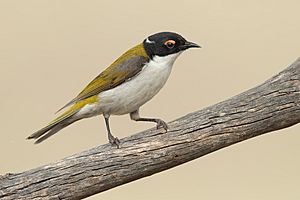White-naped honeyeater facts for kids
Quick facts for kids White-naped honeyeater |
|
|---|---|
 |
|
| Conservation status | |
| Scientific classification |
The white-naped honeyeater (scientific name: Melithreptus lunatus) is a small bird found in eastern Australia. It belongs to a group of birds called passerines, which are often known as 'perching birds'. This bird is part of the honeyeater family, called Meliphagidae.
There's another type of honeyeater, Gilbert's honeyeater, which lives in southwestern Australia. Scientists used to think it was the same species, but now they know it's different. The white-naped honeyeater is also closely related to the black-headed honeyeater found in Tasmania.
The white-naped honeyeater lives in dry eucalypt woodlands. It loves to eat sweet nectar from flowers. It also enjoys munching on insects.
Contents
Taxonomy
The white-naped honeyeater got its first scientific name, Certhia lunata, from a French bird expert named Louis Jean Pierre Vieillot in 1802. The word lunata comes from the Latin word luna, which means 'moon'. This name was chosen because of the white, moon-shaped mark on the back of the bird's neck, called its nape.
This bird is part of a group of honeyeaters called Melithreptus. Many birds in this group are similar in size and have black heads, except for the brown-headed honeyeater. The blue-faced honeyeater is a much bigger bird, but it has similar markings to the white-naped honeyeater.
Newer studies, using DNA analysis, show that honeyeaters are related to other bird families like the pardalotes, Australian warblers, and Australian fairy-wrens. These families are all part of a larger group called Meliphagoidea.
For many years, Gilbert's honeyeater, which lives in southwest Western Australia, was thought to be a subspecies of the white-naped honeyeater. It was first described as a separate species by John Gould in 1844. However, a study in 2010 looked at the birds' DNA. It showed that Gilbert's honeyeater is actually a completely different species. It split off from the other honeyeaters before the white-naped honeyeater and the black-headed honeyeater became separate species in eastern Australia.
Description
The white-naped honeyeater is a medium-sized bird, about 13–15 cm (5–6 in) long. Its back is olive-green, and its belly is white. It has a black head, the back of its neck (nape), and throat. You can spot a red patch above its eye. The most special feature is the white, crescent-shaped patch on its nape.
This bird looks a bit thinner than other similar honeyeater species. Young white-naped honeyeaters have brownish heads. The bottom part of their beak is orange. When they call, they make a sound like mjerp mjerp.
Ecology
You can find white-naped honeyeaters living in eucalypt forests and woodlands. Their main food is nectar, which is a sweet liquid from many different kinds of flowers. They also eat insects and other small creatures without backbones.
Reproduction
White-naped honeyeaters usually build their nests and lay eggs between July and December. They might even have two sets of babies during this time. Their nest is shaped like a deep bowl. It's made from grasses and small pieces of bark. They usually build it in the fork of a tall tree, often a eucalypt.
The female bird lays two or three eggs. The eggs are about 18 by 14 millimeters in size. They are shiny and have a buff-pink color, with a few red-brown spots.
See also
 In Spanish: Mielero nuquiblanco oriental para niños
In Spanish: Mielero nuquiblanco oriental para niños


